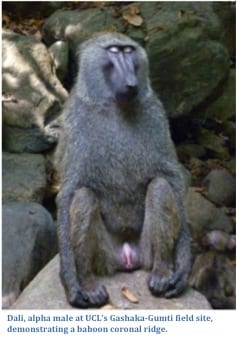Does Size Matter? Evolution and the Primate Penis
By Gemma Angel, on 17 September 2012
 by Suzanne Harvey
by Suzanne Harvey
Anatomy is destiny … The genitals themselves have not taken part in the development of the human body in the direction of beauty: they have remained animal, and thus love, too, has remained in essence just as animal as it ever was.
When Sigmund Freud wrote this in 1912, he may have been surprised to hear that some hundred years later, evolutionary theory would come to the same conclusions. Despite the frequently discussed individual variation in human penis size, the shaft of an average human penis is around twice the length and width of the shaft of an average chimpanzee penis. It is also useful to mention some more unusual facts: firstly, while chimpanzees have penises half the size of humans, they have testicles three times as large. Moreover, while silverbacks are formidable looking creatures, gorillas in fact have the smallest penis to body size ratio of any mammal. So, what causes these seemingly contradictory differences among the great apes, and how can evolutionary theory make sense of all creatures great and small?
 Sperm Competition
Sperm Competition
As Freud’s quote suggests, the clue to the evolution of the penis is not just in their physical appearance but also in the social aspects of sex. In fact, generally speaking, the mating system of a species can be used to predict penis size. Chimpanzees live in large multi-male, multi-female groups, where females are able to mate with many males. Sperm can live for up to 4 days after ejaculation, and consequently when females mate with two males in close succession, sperm from two males can be in direct competition. The male who produces more sperm will have the best chance of fertilizing an egg. This evolutionary advantage of producing large amounts of sperm can explain the relatively large testicle size of chimpanzees. Correspondingly, the male gorilla’s huge stature is in fact the reason why he has such a small penis: when competition between males occurs through physical aggression, an alpha male may fight off rivals and control his own mating success without the need for sperm competition. Other physically smaller males have little access to females in the group.
Understanding the Human Penis
The mystery of the human penis is that ancestral hominids lived in similarly large and promiscuous social groups, but did not evolve the large testicles seemingly necessary to compete via sperm competition. One might be forgiven for thinking that larger penises evolved as a result of sexual selection; the theory that a preference for larger penises in females has led to greater reproductive success for males with larger penises, with these males passing on the trait to their offspring. However, the latest research shows that penis size may also be the result of sperm competition and natural selection.
The Semen Displacement Theory (Gallup and Burch, 2004) essentially explains the advantages of the size and shape of the human penis in terms of a device evolved to remove another male’s semen before fertilization.
As well as being larger and wider than other primate penises, the human penis has the unique shape of a shaft with a ridge leading to a wider tip, known as the coronal ridge. This is more pronounced than in other species. All of these elements are important in terms of semen displacement: the coronal ridge removes semen by ‘scooping it out’ as it passes over the tip, is trapped behind the ridge and pulled out during intercourse. Recent research shows that (using artificial genitalia) a penis with a coronal ridge will displace 91% of semen, while one without will displace only 35% (Gallup et al. 2003). Thrusting during sex creates a vacuum that aids this process, as the width of the shaft provides a plug in the vagina. In Gallup’s experiment, the same penis removed 90% of semen when fully inserted and only 39% when inserted three quarters of the way. Therefore, the length of the shaft simply improves reach and maximizes the amount of semen that can be removed.
 So yes, when it comes to penises, size – and shape – matters when it comes to natural selection!
So yes, when it comes to penises, size – and shape – matters when it comes to natural selection!
Suzanne Harvey is a PhD student in Biological Anthropology, working on social interactions and communication in wild olive baboons. She is also a teaching assistant on the UCL Arts and Sciences BASc, a new interdisciplinary degree, and can be found on twitter @suzemonkey.
References:
Freud, S. (1912). On the Universal Tendency to Debasement in the Sphere of Love. Oxford Literary Review 30: 109-146 DOI 10.3366/E0305149808000199, ISSN 0305-1498
Gallup, G. G. & Burch, R. L. (2004). Semen Displacement as a Sperm Competition Strategy in Humans. Evolutionary Psychology 2: 12-23
Gallup, G. G., Burch, R. L., Zappieri, M. L., Parvez, R. A., Stockwell, M. L. & Davis, J. A. (2003). The human penis as a semen displacement device. Evolution and Human Behavior 24: 277–289
 Close
Close

